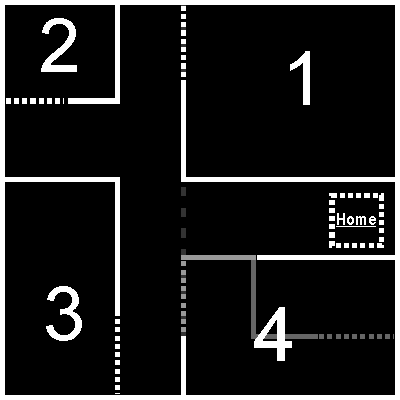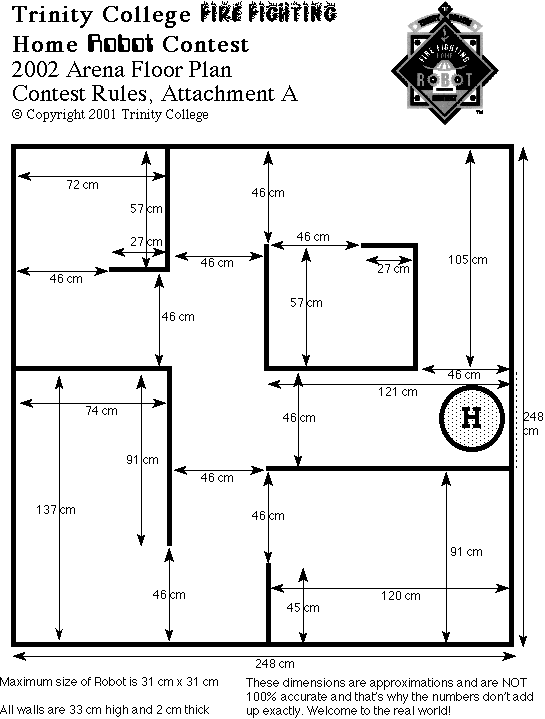The Contest
Overview
The Western Canadian Robot Games are held anually at SAIT in Alberta. Consisting of many different
events the WCRG is one of the biggest robot competitions in Canada and North America, more info can
be found at www.robotgames.com. Although the firefighting
contest is a major part of the games it was originally developed by Trinity College, the WCRG adaption
is less complex than the Trinity College version but still quite challenging, more info can be found
at www.trincoll.edu/events/robot.
The firefighting contest is designed to model a real-world situation where robots would be used to
locate and extinguish a fire in a warehouses or possibly even homes. To simulate this our robot must
navigate a simple, predefined, maze and extinguish a blazing inferno (a candle). This is actually a
lot tougher than it sounds, here are a few of the problems we had last time:
-
Navigation:
Last year our robot determined it's position by using a combination of "Wall Hugging" and
"Dead Reckoning" this caused problems as both the techniques required us to time how fast our
and hardcode that into the programming, when we got to the contest we discovered that the
maze surface was higher-friction than our test maze, so it didn't turn or detect corners properly.
Another thing that hampered our robots navigation was our lack of a full-size maze to debug it on
(we used bits of scrap wood stuck together with double-sided sticky tape).
-
Candle Detection:
Our previous robot detected the candle by measuring ambient light, this worked fine when testing
it in dimly lit basements but when we got it to the contest the maze was in a skylit hall and
the ambient light was even through the whole maze (even the room with the candle).
Maze Diagrams
Top of page
WCRG:

Trinity College:

Design Specifications
Top of page
Robot Operation
Once turned on the robot must be self-controlled without ant human intervention, that is, these are to be
autonomously controlled and not manually controlled devices.
The robot can bump into or touch the walls of the house as it travels, but can not mark or damage the walls
in doing so.
The robot can not leave anything behind as it travels through the house. It can not make any marks on the
floor of the house as it travels.
The robot must, in the opinion of the official judges, have found the candle before it attempts to put it
out. The robot must find the candle before it puts it out. The robot can not just flood the house structure
with CO2 and put it out by accident.
Extinguishing the Candle
The robot must not use any destructive or dangerous methods to put out the candle. It can use such items
as water, air, CO2, etc, but any method or material that is dangerous or will damage the house is
prohibited. For example, the robot can not explode a firecracker and put the candle out with the
concussion. The robot can not knock the candle over to put it out
If a robot accidentally knocks over a candle after it has been put out then it is all right and the robots
trail run will count. The candle will be mounted on a weighted base so that it will not be easily knocked
over by moving air or water.
Any mess that a robot makes (water, whipping cream, etc) will be cleaned up by the owner of the robot.
Robot Size and Weight
The maximum size of the robot shall be 12" by 12" by 12". The robot can not look over the walls of the
structure and must never extend itself beyond 12" in height.
There are no restrictions on the weight of the robot.
There are no restrictions on the type of materials used in the creation of the robot, except that the
robot must be designed and constructed by the contestants.
There are no restrictions on the type of sensors that can be used as long as they do not violate any of the
other rules or regulations.
No external cables may be connected to the robot. For instance, the robot must not be connected to an external
computer system for instructions.
Top of page
Printable Version
|